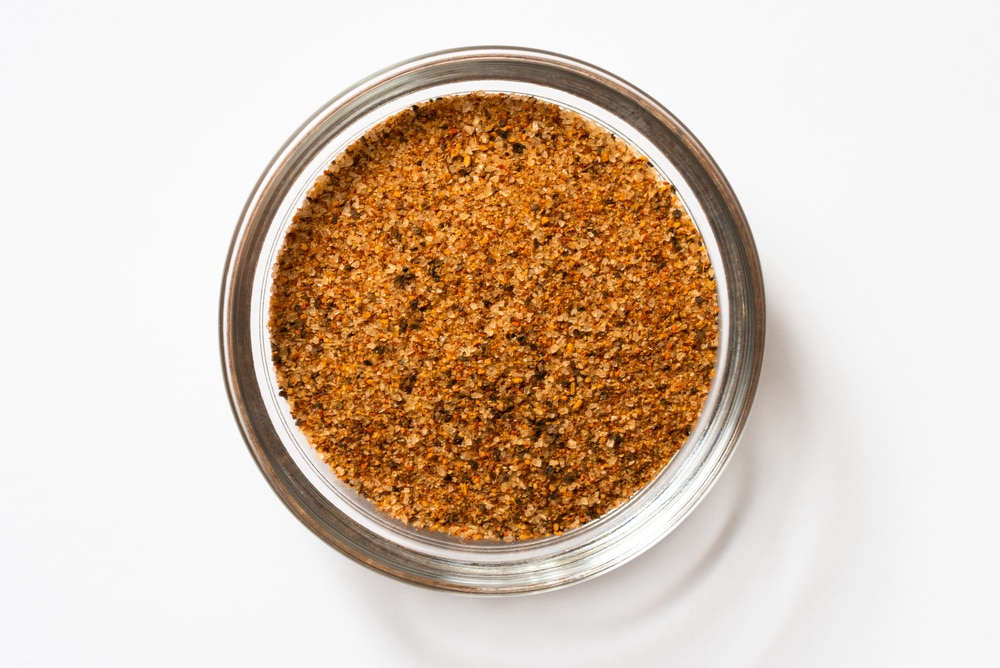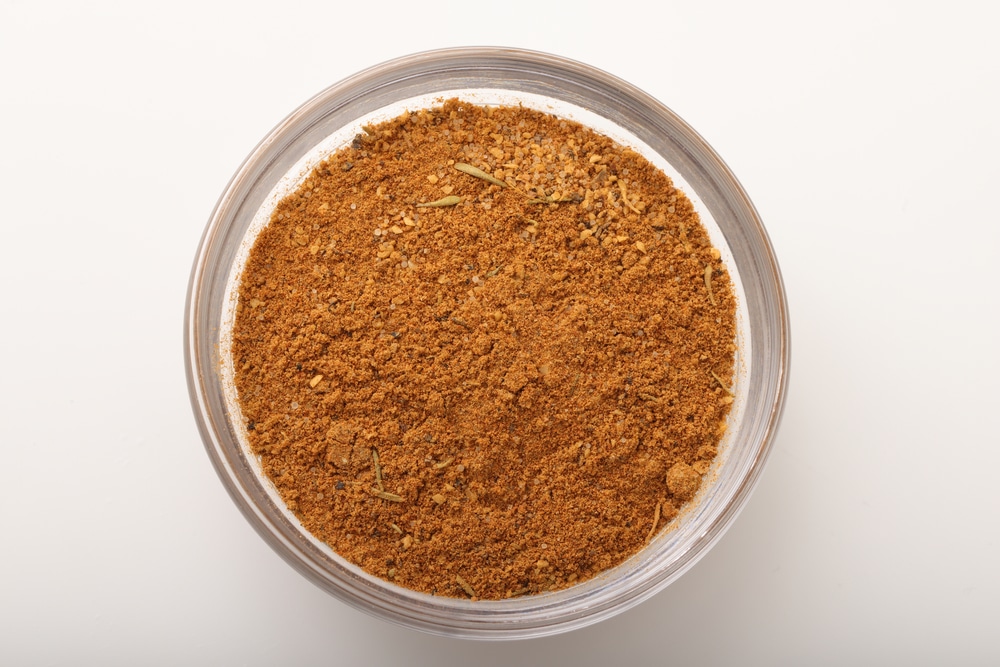Cajun and Creole seasoning are popular spice blends used in various dishes— but how do they differ? Are they the same? Are they interchangeable?
Cajun vs Creole Seasoning
The main difference between Cajun and Creole seasoning is the pepper used in each seasoning. Cajun uses cayenne pepper to provide a little heat to a dish, while Creole seasoning uses several kinds of pepper— black, white, and cayenne.
Hotter Creole seasoning might contain flakes or powder from hotter peppers.
- Appearance: Cajun seasoning is usually a darker red, while Creole seasoning is a brighter red due to the higher concentration of the red cayenne pepper.
- Flavor: Cajun seasoning tastes spicy but isn’t usually hot, whereas Creole seasoning, with more kinds of peppers included, can be hot enough to make you sweat while you eat it.
- Shelf Life: Both Cajun and Creole seasonings, like many spices and seasoning blends, have shelf lives of between two and three years.
- Use Cases: Both seasonings are very versatile, and many chefs use them on all kinds of meats, including poultry and seafood, in soups, gumbos, even on sides like French fries or fried okra.
While Cajun and Creole foods, costumes, and sensibilities both center in and around New Orleans, the two cultures have very different origins. The seasoning blends are similar in their contents, but they are not identical. Each one imparts specific qualities to the dishes in which it’s used.
Cajuns were of French origin, coming to the New World and settling in Canada in the 17th century. They called their new home Acadia, but they found themselves forced south when they wouldn’t bow the knee to King Charles II of England. New Orleanians called them Acadians. Bastardization eventually turned that into “Cajun.”
On the other hand, the Creoles were generally people of a much more diverse background. Often raised in or near the West Indies, Creoles tended to have French ancestry and Native American, black, or Spanish roots. Many of them were what we now would call mixed race.
Comparison Table Between Cajun and Creole Seasoning
| Ingredients | Cajun Seasoning | Creole Seasoning |
| Basil | x | x |
| Black pepper | x | x |
| Cayenne pepper | x | x |
| Garlic powder | x | |
| Onion powder | x | x |
| Oregano | x | x |
| Paprika | x | x |
| Salt | x | x |
| Thyme | x | x |
| White pepper | x |
While this list of basic ingredients shows the two blends to be nearly identical, there is a lot more cayenne in Creole seasoning and more paprika. Adding the garlic, in addition to the larger dose of pepper ingredients, makes Creole much hotter than Cajun, though both add spiciness to any dish.
Can You Substitute Cajun Seasoning for Creole Seasoning?
Due to their similar makeup, the two seasonings can be used interchangeably, but you will want to be aware of what you’ll be getting when using one instead of the other.
You don’t have to scale the amount you use— if a recipe calls for a tablespoon of Cajun seasoning, you can absolutely use a tablespoon of Creole seasoning instead, but you’ll need to be aware of the difference in heat you’ll get.
If you or your diners are overly sensitive to hot, spicy food, using the same amount of Creole seasoning that the recipe asks for of Cajun seasoning will make the dish quite a bit hotter than it would have been with Cajun seasoning.
The reverse is true, too— if you need a teaspoon of Creole seasoning but have only Cajun, then you’ll need to use more than the recipe calls for to approach the spicy kick the Creole seasoning would have brought.
For a ratio, start with 2:1, then adjust for taste as you need to. Unlike baking, when it comes to cooking, if your measurements aren’t precise, you can still have a very successful dish. If what you’re making calls for a tablespoon of Cajun seasoning, start with one and a half teaspoons of Creole seasoning.
Need one teaspoon of Creole, but only have Cajun? Start with two teaspoons. If you taste it and feel like the dish needs more heat, add a little more.
What is Cajun Seasoning?

Cajun seasoning is a blend of spices with European connotations that have been ratcheted up to a New World flavor with the addition of a little cayenne pepper. The earthy flavors of thyme, basil, and oregano that form the flavor palate of many European cuisines join with the cayenne to boost the flavor mix.
Is creole seasoning spicy? It is, but it won’t make your food too hot to be enjoyable. The heat of the cayenne pepper doesn’t mask the flavors. A dish flavored with Cajun seasoning will rarely be so hot as to make the diners sweat or feel like they’re on an episode of “Hot Ones.”
How to Use Cajun Seasoning
Chefs use Cajun seasoning to give an instant Southern or New Orleans vibe to food, and unless you’re talking about breakfast cereal, pretty much anything you cook can benefit from it. Use it as a rub before cooking or grilling meat, chicken, pork, or seafood, but also realize that you can almost treat it like salt— a more complex salt.
Mix it into the breading you’ll coat something in before you fry it, sprinkle it on corn on the cob before or after it goes on the grill, season vegetables with it, or season your gumbo with it. Stirring Cajun seasoning into the roux for your gumbo is kind of imperative, actually.
What is Creole Seasoning?

Creole seasoning is much spicier than Cajun seasoning. It uses more cayenne pepper. It also contains garlic that Cajun seasoning doesn’t have. In addition to the cayenne, it usually contains ground black pepper and white pepper, which generally isn’t as hot as black pepper.
Still, it’s pepper. It brings a little heat with it, and when added to the other peppers, and considering that Creole seasoning uses much more cayenne than Cajun does, the seasoning blend is hotter and spicier.
The culinary traditions of the West Africans whose cooking proliferated in the West Indies called for hotter spices. Before slavers forcibly brought these men and women to the New World, many West African cultures used spices from the Arab part of the world.
The slave trade brought chilies to Africa, so when those people found themselves on the other side of the world, they couldn’t get the Arab stuff, but they still had peppers. One reason the Africans preferred such heat in their food stemmed from the hot climate in which they lived.
The West Africans understood the principle of evaporative cooling. They knew that if they ate hot foods, they would sweat. In turn, the sweat helped cool their bodies. The fact that spicy foods tasted great was probably just icing on the cake.
How to Use Creole Seasoning
The way you use Creole seasoning can be summed up in a word: carefully. This is especially true if you or your dinner guests are particularly sensitive to hot foods. Think of it this way: if Cajun seasoning were a jalapeno pepper, Creole seasoning might be a habanero pepper.
Maybe that’s too extreme a choice for Creole, but the principle remains the same: when using a habanero in your cooking, you’ll use less than you would with a jalapeno unless you want your food to be hotter than it would be with that jalapeno.
Using it as a dry run for your meat or poultry means using less than you would if you were using Cajun seasoning unless you want markedly hotter food. Just like too much salt can ruin a dish, too much heat can make your food less than palatable to some.
Conclusion
Spices and seasonings can make good food great, and they can make great food transcendent. However, knowing the flavors of the seasonings you use is important, as is (especially in the case of Cajun and Creole seasoning) the knowledge of how much heat each will bring to your dish.
Experiment with each, but remember that Creole seasoning is generally hotter. Whether you buy it from a store or mix it yourself, Creole seasoning contains more pepper (and different kinds) than Cajun seasoning. Both bring terrific flavors reminiscent of the South, and the amount of heat you want in your food will dictate how much or even what kind of seasoning you use.






